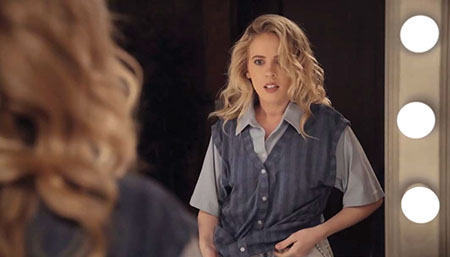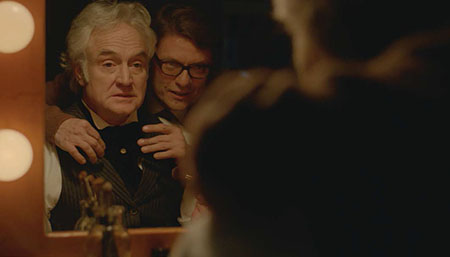Taking Advantage of Practicals
Something that seems a bit underestimated is the power that practicals have. A practical is a light that is seen on screen, an apparent source, that is utilized to light the space and/or subject. This could range from a computer screen, lamp, fluorescent fixture on the wall and so much more. If you see it in the frame, it’s a practical.

I’ve shot quite a few makeup mirrors where a great number of bulbs have had to be swapped out, but it ends up saving the shot. In two music videos, one for Shayna Leigh (“Jerry Seinfeld”)
A GREAT STARTING POINT
The most obvious reason practicals are so effective is because the viewer buys them as a natural fixture in the space. They not only add highlights and shapes within the picture you are painting, but they’re easily motivated. Practicals give you a great starting point if you choose to add film lights because you can bring in your own units to extend the effects of them. Not only can you extend a practical’s illumination in the frame, but deeper in the frame you can add light as if there are more of the same light fixtures elsewhere in a room.
Just as you are making exposure decisions with your film lights, you have to do so with the practicals you use. A new challenge is dealing with seeing these sources because depending on the output, you could be dealing with a super bright spot in the frame. I usually meter a lot on set, so when I have a practical in the frame, I am not only taking incident readings of how much light is falling onto my subjects, but now I am spot reading as well. Spot readings help a lot with brights sources inside the frame, where light is now being reflected instead of absorbed.
Using practicals in a scene is not a matter of just walking into a space and using what is already in the room; it is important to have control over them. I always say that the production designer is your best friend on set, one of the reasons being you can discuss the types of fixtures you can bring into the scene from outside the location.

Aimee Mann (“Patient Zero”), we had two significant scenes where the camera was looking into makeup mirrors.
On one period film I worked on, there was no electricity, so we had to rely on extending the effects of kerosene lanterns, which production design supplied. In modern day films, lamps are still popular within scenes, mostly in narrative, and I am always having to replace what already exists in the space. You always want to have options and/or a clear idea of what you want in the design of a room. In addition to having the right lamp or other light, you want to also have the right wattage of bulb for exposure. If you cannot supply separate bulbs, then having a few hand dimmers if your package will help reduce the intensity of practicals that are too bright. I prefer to switch things out, because depending on the fixture you can end up with flickering issues on camera that are sometimes invisible to the eye.
The professional video industry's #1 source for news, trends and product and tech information. Sign up below.
I’ve shot quite a few makeup mirrors where a great number of bulbs have had to be swapped out, but it ends up saving the shot. In two music videos, one for Shayna Leigh and another for Aimee Mann, we had two significant scenes where the camera was looking into makeup mirrors. For Shayna’s video, I didn’t add any other key, but to light Bradley Whitford, I armed out a small tungsten Fresnel to supplement. For both of these projects, I bought lower wattage incandescent bulbs, around 60W, and placed though inside the mirrors. You never know what the power of the bulbs on location will be.
KITS IN THE HALL
Another popular instance of practicals is in a hallway. Hallways may be lined with green fluorescent fixtures or sconces on the wall, which you then have to supplement or embrace. A good trick is if you are going to fly with using the lights in the hall, is to kill some of the them, and leave others on. Gently unscrewing the bulbs so that they turn off if every light is on the same circuit can give you more control, or even skirting the ones that are on with some black fabric like duvetyne helps give you more shape.
Practicals are an easy way to add highlights in the frame for some depth, as well as motivate your key and other lights painting the picture. During a single project on location, it will always be a mix of replacing and embracing the practicals that exist in the space, unlike starting from scratch in an empty stage where you are building a set. No matter what you are presented with in a location, there typically several options and it is important to not let practicals limit you. All of a light’s properties are controllable, and you have to make it work for you. Whether you need them to match the color of a film light you’re bringing in or just need them to be less intense, you can always find a way to get it just right.
Julia Swain is a cinematographer based in California, whose narrative films include “Killing Animals,” “Jilted” and “Cassidy Red.” She continues to shoot on a variety of formats, seeking to create compelling visuals for every story and brand. She can be contacted through TV Technology.
